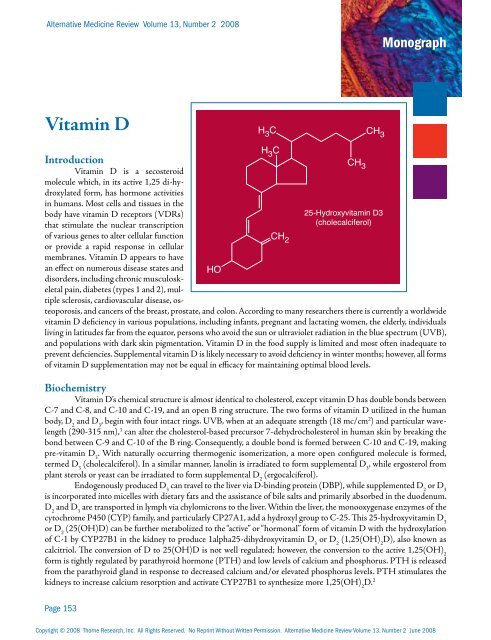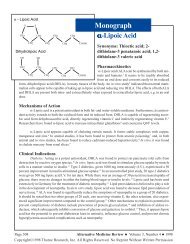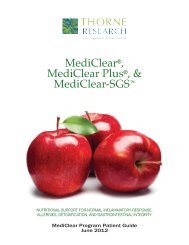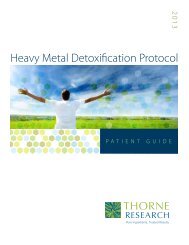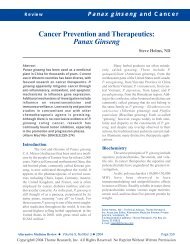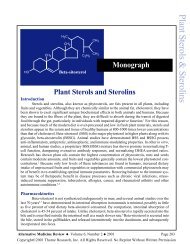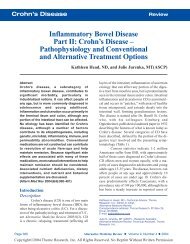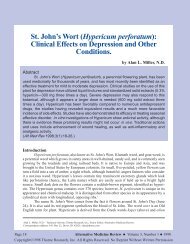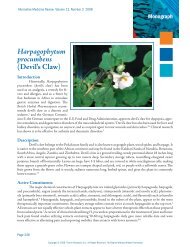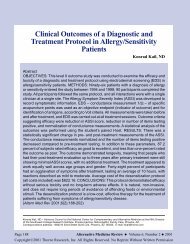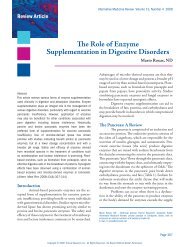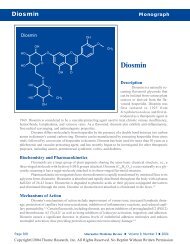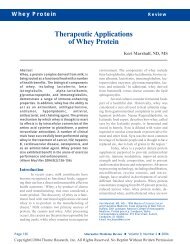Create successful ePaper yourself
Turn your PDF publications into a flip-book with our unique Google optimized e-Paper software.
Alternative Medicine Review Volume 13, Number 2 2008<br />
<strong>Vitamin</strong> D<br />
Introduction<br />
<strong>Vitamin</strong> D is a secosteroid<br />
molecule which, in its active 1,25 di-hydroxylated<br />
form, has hormone activities<br />
in humans. Most cells and tissues in the<br />
body have vitamin D receptors (VDRs)<br />
that stimulate the nuclear transcription<br />
of various genes to alter cellular function<br />
or provide a rapid response in cellular<br />
membranes. <strong>Vitamin</strong> D appears to have<br />
an effect on numerous disease states and<br />
disorders, including chronic musculoskeletal<br />
pain, diabetes (types 1 and 2), multiple<br />
sclerosis, cardiovascular disease, os-<br />
Page 153<br />
HO<br />
Monograph<br />
Copyright © 2008 <strong>Thorne</strong> <strong>Research</strong>, Inc. All Rights Reserved. No Reprint Without Written Permission. Alternative Medicine Review Volume 13, Number 2 June 2008<br />
H 3 C<br />
H 3 C<br />
CH 2<br />
CH 3<br />
CH 3<br />
25-Hydroxyvitamin D3<br />
(cholecalciferol)<br />
teoporosis, and cancers of the breast, prostate, and colon. According to many researchers there is currently a worldwide<br />
vitamin D deficiency in various populations, including infants, pregnant and lactating women, the elderly, individuals<br />
living in latitudes far from the equator, persons who avoid the sun or ultraviolet radiation in the blue spectrum (UVB),<br />
and populations with dark skin pigmentation. <strong>Vitamin</strong> D in the food supply is limited and most often inadequate to<br />
prevent deficiencies. Supplemental vitamin D is likely necessary to avoid deficiency in winter months; however, all forms<br />
of vitamin D supplementation may not be equal in efficacy for maintaining optimal blood levels.<br />
Biochemistry<br />
<strong>Vitamin</strong> D’s chemical structure is almost identical to cholesterol, except vitamin D has double bonds between<br />
C-7 and C-8, and C-10 and C-19, and an open B ring structure. The two forms of vitamin D utilized in the human<br />
body, D 2 and D 3 , begin with four intact rings. UVB, when at an adequate strength (18 mc/cm 2 ) and particular wavelength<br />
(290-315 nm), 1 can alter the cholesterol-based precursor 7-dehydrocholesterol in human skin by breaking the<br />
bond between C-9 and C-10 of the B ring. Consequently, a double bond is formed between C-10 and C-19, making<br />
pre-vitamin D 3 . With naturally occurring thermogenic isomerization, a more open configured molecule is formed,<br />
termed D 3 (cholecalciferol). In a similar manner, lanolin is irradiated to form supplemental D 3 , while ergosterol from<br />
plant sterols or yeast can be irradiated to form supplemental D 2 (ergocalciferol).<br />
Endogenously produced D 3 can travel to the liver via D-binding protein (DBP), while supplemented D 2 or D 3<br />
is incorporated into micelles with dietary fats and the assistance of bile salts and primarily absorbed in the duodenum.<br />
D 2 and D 3 are transported in lymph via chylomicrons to the liver. Within the liver, the monooxygenase enzymes of the<br />
cytochrome P450 (CYP) family, and particularly CP27A1, add a hydroxyl group to C-25. This 25-hydroxyvitamin D 3<br />
or D 2 (25(OH)D) can be further metabolized to the “active” or “hormonal” form of vitamin D with the hydroxylation<br />
of C-1 by CYP27B1 in the kidney to produce 1alpha25-dihydroxyvitamin D 3 or D 2 (1,25(OH) 2 D), also known as<br />
calcitriol. The conversion of D to 25(OH)D is not well regulated; however, the conversion to the active 1,25(OH) 2<br />
form is tightly regulated by parathyroid hormone (PTH) and low levels of calcium and phosphorus. PTH is released<br />
from the parathyroid gland in response to decreased calcium and/or elevated phosphorus levels. PTH stimulates the<br />
kidneys to increase calcium resorption and activate CYP27B1 to synthesize more 1,25(OH) 2 D. 2
Alternative Medicine Review Volume 13, Number 2 2008<br />
PTH also activates osteoblasts that facilitate<br />
the conversion of preosteoclasts to osteoclasts. Osteoclasts<br />
dissolve bone to free up calcium to negate the deficiency<br />
that originally activated the parathyroid gland<br />
to secret PTH. Over-production of active vitamin D is<br />
inhibited by a negative feedback loop; 1,25(OH) 2 D inhibits<br />
PTH, stimulates the release of fibroblast growth<br />
factor 23 (FGF23) from osteoblasts, and induces the<br />
enzyme CYP24A1. FGF23 reduces circulating phosphorus<br />
by altering kidney production of a sodium<br />
phosphorus co-transporter and inhibits the vitamin-D<br />
activating enzyme CYP27B1. CYP24A1 places a hydroxyl<br />
group on C-24 of 1,25(OH) 2 D, allowing for its<br />
metabolism into calcitriol and excretion in the bile. 2,3<br />
Pharmacokinetics<br />
Due to its metabolism into many inactive and<br />
excretable forms, less than 25 percent of vitamin D becomes<br />
25(OH)D. 4 <strong>Vitamin</strong> D is stored in both muscle<br />
and fat tissue, with vitamin D 3 levels in the serum correlated<br />
to the amount of D 3 in fat tissue. 5 Studies of radioactively<br />
labeled D 3 find the whole body half-life of<br />
vitamin D 3 molecules to be approximately 62 days. 6<br />
The potency of D 3 or D 2 is determined by the<br />
molecule’s ability to raise 25(OH)D levels. Because of<br />
differences in chemical structure (D 2 differs from D 3 by<br />
having a methyl group attached to C-24 and a double<br />
bond between C-22 and C-23), vitamins D 2 and D 3<br />
have similar but variable metabolism. In one study, 20<br />
healthy males were given single 50,000-IU doses of either<br />
D 2 or D 3 , and serum levels of D 2 , D 3 , as well as<br />
25-hydroxylated versions of vitamins D 2 and D 3 were<br />
measured over a 28-day period. Although the two<br />
forms demonstrated similar rises in serum 25(OH)D<br />
levels over three days, the D 2 -treated group experienced<br />
a rapid decline to baseline levels at day 14 and were well<br />
below baseline by day 28. By contrast, 25(OH)D levels<br />
in the D 3 -treated group peaked at day 14 and remained<br />
significantly elevated throughout the study. As a result,<br />
the authors concluded, “The data presented in this paper<br />
indicate that the 50,000-IU dosage form of vitamin<br />
D 2 should be considered to be equivalent to no more<br />
than 15,000 IU of vitamin D 3 and perhaps closer to<br />
only 5,000 IU. In any event, the tolerable upper intake<br />
level, 2,000 IU/d published for vitamin D 3 , and already<br />
judged to be set too low, ought not be applied to vitamin<br />
D 2 .” 7<br />
<strong>Vitamin</strong> D<br />
According to a 2006 commentary in American<br />
Journal of Clinical Nutrition, studies have indicated vitamin<br />
D 2 supplementation results in inferior elevation of<br />
25(OH)D levels, decreased binding affinity to DBP in<br />
plasma, and a shorter shelf life. The authors Houghton<br />
and Vieth conclude by stating, “<strong>Vitamin</strong> D 2 , or ergocalciferol,<br />
should not be regarded as a nutrient suitable for<br />
supplementation or fortification.” 8<br />
Mechanism of Action<br />
Active 1,25(OH) 2 D has both endocrine and<br />
autocrine hormone activity. It binds to vitamin D receptors<br />
in the nucleus of cells and, with a retinoid X<br />
receptor (RXR) partner, binds specific regions of DNA<br />
named vitamin D response elements (VDRE) located<br />
in the promoter region of genes. The heterodimeric<br />
group then allows the binding of co-activator protein<br />
complexes that link the RXR-VDR group to transcription<br />
start sites. With most human cells expressing<br />
VDRs, 1,25(OH) 2 D has the potential to alter the function<br />
of most tissues in the body. The enzyme responsible<br />
for the rate-limiting step for the formation of 1,25D,<br />
1-alpha hydroxylase (CYP27B1), has been found in<br />
the pancreas, prostate, breast, macrophages, epidermis,<br />
parathyroid gland, and intestines. Other non-VDRE<br />
related interactions are being investigated. 9<br />
Deficiency<br />
<strong>Vitamin</strong> D status is determined by measuring<br />
serum 25(OH)D. Holick, 10 Vieth, 11 and Bischoff-Ferrari<br />
et al 12 agree a minimum 25(OH)D serum concentration<br />
of 30 ng/mL (75 nmol/L) appears necessary to<br />
experience the multitude of beneficial health effects of<br />
vitamin D. Cannell and Hollis 13 argue higher levels of<br />
>40 ng/mL may be needed, and persons with heart disease,<br />
MS, autism, diabetes, and cancer may benefit from<br />
>55 ng/mL serum 25(OH)D levels year round. Garland<br />
et al 14 estimates the risk for two common cancers<br />
could be reduced by 50 percent when levels of 25(OH)<br />
D are maintained at or above 34 ng/mL for colon cancer<br />
and 52 ng/mL for breast cancer.<br />
Many researchers have concluded there is a<br />
worldwide epidemic of vitamin D deficiency. Of 28<br />
studies assessing worldwide vitamin D status, Thailand<br />
was the only country that demonstrated a study population<br />
with mean serum values above 33 ng/mL. 15 As an<br />
Page 154<br />
Copyright © 2008 <strong>Thorne</strong> <strong>Research</strong>, Inc. All Rights Reserved. No Reprint Without Written Permission. Alternative Medicine Review Volume 13, Number 2 June 2008
Monograph<br />
important hormone in the human body with receptors<br />
in a multitude of tissues, a lack of vitamin D can initiate,<br />
precipitate, and exacerbate a host of health disorders.<br />
Symptoms may manifest as inflammatory diseases,<br />
bone metabolism disorders, infectious diseases, and immunological<br />
imbalances. Dietary sources of vitamin D<br />
are inadequate to meet daily requirements. Therefore,<br />
the majority of the world’s population relies on unimpeded<br />
skin exposure to UVB radiation to allow for endogenous<br />
production of vitamin D or vitamin D supplementation.<br />
Any factor that impedes the endogenous<br />
or exogenous absorption, formation, or transformation<br />
of this nutrient may contribute to deficiency. 10,13<br />
There are many potential barriers to UVB radiation<br />
reaching the skin in adequate amounts for photolysis<br />
to occur. Clothing, 16 dark skin pigmentation, 17<br />
sunscreen, 18 air pollution, cloud cover, time of day, distance<br />
from the equator, and atmospheric ozone content<br />
can limit UVB photon strength or passage through the<br />
skin. 19 Elderly populations have lower levels of 7-dehydrocholesterol<br />
and many have limited exposure to adequate<br />
UVB radiation. 20,21<br />
<strong>Vitamin</strong> D is a fat-soluble nutrient absorbed<br />
primarily in the duodenum. Individuals with malabsorptive<br />
disorders of the small intestine, such as those<br />
with celiac disease, 22 cystic fibrosis, 23,24 and Crohn’s disease,<br />
25 or populations that have undergone gastric bypass<br />
surgery 26,27 may be at increased risk for vitamin D<br />
deficiency. 28 Obesity is also a risk factor for deficiency<br />
due to the inability of fat tissue to sequester vitamin<br />
D. 29 <strong>Vitamin</strong> D needs increase during pregnancy and<br />
lactation. Limited vitamin D passes through the breast<br />
milk. As a result, many pregnant women and their offspring<br />
are vitamin D deficient. 30<br />
The liver and kidneys play direct and indirect<br />
roles in vitamin D physiology; therefore, diseases of either<br />
organ can adversely affect vitamin D status. 10<br />
Clinical Indications<br />
Osteoporosis/Fracture<br />
Suboptimal calcium absorption, secondary<br />
hyperparathyroidism, increased bone resorption, decreased<br />
muscle strength, and increased risk of falling<br />
can be related to vitamin D deficiency/insufficiency,<br />
which in the elderly increases fracture risk. 31<br />
Page 155<br />
Alternative Medicine Review Volume 13, Number 2 2008<br />
The number of falls experienced by elderly<br />
women in geriatric care was reduced 49 percent when<br />
they were given 800 IU vitamin D 3 and 1,200 mg calcium<br />
(as carbonate) for 12 weeks, compared to a control<br />
group receiving the same amount of calcium and no vitamin<br />
D. 32<br />
<strong>Vitamin</strong> D deficiency is common in patients<br />
with osteoporotic fractures, with two studies showing<br />
95-97 percent of fracture patients being classified as vitamin<br />
D deficient. 33,34<br />
When 100,000 IU vitamin D 3 was given every<br />
four months to 2,686 community-living 65- to 85-yearold<br />
men and women, a 33-percent reduction in fractures<br />
was seen at the most common osteoporotic sites including<br />
hip, spine, wrist, and forearm over a five-year period. 35<br />
A meta-analysis of prospective cohorts and<br />
randomized trials found an average 25-percent risk reduction<br />
for non-vertebral and hip fractures when study<br />
subjects were given 700-800 IU of supplemental vitamin<br />
D per day. Results were consistent in the presence<br />
or absence of calcium supplementation beyond adequate<br />
dietary calcium intake. The authors concluded: “Thus,<br />
calcium additional supplementation may not be critical<br />
for non-vertebral fracture prevention once 700-800 IU<br />
of vitamin D are provided.” 36<br />
<strong>Research</strong>ers in Iceland confirmed the importance<br />
of vitamin D in calcium homeostasis via its effect<br />
on PTH by saying: “<strong>Vitamin</strong> D may have a calcium<br />
sparing effect and as long as vitamin D status is ensured,<br />
calcium intake levels of more than 800 mg/day may be<br />
unnecessary for maintaining calcium metabolism.” 37<br />
<strong>Vitamin</strong> D can have profound effects on osteoporosis;<br />
however, researchers were surprised to find that<br />
of 1,246 postmenopausal women taking pharmacological<br />
medication for osteoporosis therapy, 52 percent had<br />
serum 25(OH)D levels below 30 ng/mL, and 16.5 percent<br />
showed biochemical signs of secondary hyperparathyroidism.<br />
38<br />
Longevity/Anti-Aging<br />
A recent meta-analysis of 18 randomized controlled<br />
trials examining data from 57,311 participants<br />
over a mean follow-up period of 5.7 years revealed a relative<br />
risk of mortality from any cause to be 0.93 (95% CI:<br />
0.87-0.99) in the study groups that took supplemental<br />
vitamin D (mean daily dose was 528 IU) compared to<br />
groups without supplementation. 39<br />
Copyright © 2008 <strong>Thorne</strong> <strong>Research</strong>, Inc. All Rights Reserved. No Reprint Without Written Permission. Alternative Medicine Review Volume 13, Number 2 June 2008
Alternative Medicine Review Volume 13, Number 2 2008<br />
<strong>Research</strong>ers studying serum values of vitamin<br />
D in 2,160 twins found higher vitamin D levels may<br />
alter telomere length of leukocytes. “The difference between<br />
the highest and lowest tertiles of vitamin D was<br />
107 base pairs (p=0.0009), which is equivalent to 5.0 y<br />
of telomeric aging.” The authors go on to state that this<br />
finding “…underscores the potentially beneficial effects<br />
of this hormone on aging and age-related diseases.” 40<br />
Cardiovascular Disease<br />
Hypertension, diabetes mellitus, obesity, and<br />
hyperlipidemia can lead to atherosclerosis and consequently<br />
fatal myocardial infarctions. Along with cerebrovascular<br />
disease, these health disorders are considered<br />
to be the most common contributing factors to death<br />
worldwide in both adult males and postmenopausal females.<br />
Secondary analysis of the Third National Health<br />
and Nutrition Examination Survey (NHANES III)<br />
found that participants with a serum 25(OH)D level of<br />
Monograph<br />
Preeclampsia<br />
Preeclampsia, a potentially serious complication<br />
of late second and third trimester of pregnancy,<br />
includes hypertension, edema, proteinuria, and sudden<br />
weight gain. A nested, case-control study investigated<br />
25(OH)D levels in early pregnancy and the risk of<br />
preeclampsia, as well as the 25(OH)D status of newborns<br />
of preeclamptic mothers. In women who developed<br />
preeclampsia, 25(OH)D levels were lower in early<br />
pregnancy compared to controls (18.2 ng/mL vs. 21.3<br />
ng/mL). After adjusting for season, gestational age, prepregnancy<br />
body mass index, education, and race/ethnicity,<br />
the researchers found a five-fold increase in the<br />
odds of preeclampsia (95% CI: 1.7-14.1) for those with<br />
25(OH)D
Alternative Medicine Review Volume 13, Number 2 2008<br />
follows. By binding with various VDRs, 1,25(OH) 2 D<br />
causes gene transcription that inhibits CD4 T-cells<br />
from expressing a T-helper 1 dominant cytokine profile<br />
including IFN-γ and TNF-α, and promotes a T-helper<br />
2 cytokine profile including increased expression of<br />
IL-4, IL-5, and IL-13. Active 1,25(OH) 2 D also helps<br />
promote the growth and differentiation of CD4 T-cells<br />
to T-regulatory cells associated with the less inflammatory<br />
cytokines IL-10 and transforming growth factorbeta.<br />
75<br />
In a 2006 prospective, nested case-control study<br />
in a cohort of more than seven million U.S. military<br />
personnel, blood samples and serum levels of 25(OH)<br />
D were analyzed to determine a correlation between the<br />
risk of MS and levels of 25(OH)D. The risk of MS decreased<br />
40 percent in Caucasian men and women with<br />
every 20-ng/mL increase in circulating 25(OH)D. Between<br />
the highest quintile of 25(OH)D concentration<br />
(>39.7 ng/mL) and lowest (
Monograph<br />
A cross-sectional study of 150 patients presenting<br />
to the health clinic at the University of Minnesota<br />
with nonspecific musculoskeletal pain found 140<br />
(93%) were vitamin D deficient (mean 25(OH)D level<br />
of 12.08 ng/mL; 95% CI: 11.18-12.99). 89<br />
German researchers found a “strong correlation<br />
between low 25(OH)D levels and higher rates and longer<br />
duration of generalized bone and/or muscle pain.” 90<br />
Older women, but not men, with vitamin D<br />
deficiency (56,667 IU/day for seven months) 104<br />
 Fourteen people with oil-based vitamin D<br />
supplements accidentally used for cooking oil (2<br />
million IU/g for 11 subjects and 5 million IU/mL<br />
for three subjects) 105,106<br />
 Two individuals with undiluted vitamin<br />
supplements (both >155,000 IU/day up to<br />
2,000,000 IU) 107,108<br />
 One child with accidental overdose by mother<br />
administering imported concentrated liquid<br />
supplement (60,000 IU/day for a two-year-old) 109<br />
Some define vitamin D toxicity as the presence<br />
of hypercalcemia (>2.75 mmol/L on one occasion) and<br />
an elevated 25(OH)D level (>150 ng/mL). Urinary<br />
calcium:creatinine ratios >1 often precede hypercalcemia.<br />
6,79,103<br />
Common symptoms of hypervitaminosis D<br />
and hypercalcemia are anorexia, weight loss, weakness,<br />
fatigue, disorientation, vomiting, dehydration, polyuria,<br />
constipation, fever, chills, abdominal pain, and renal<br />
dysfunction. 110,111<br />
Copyright © 2008 <strong>Thorne</strong> <strong>Research</strong>, Inc. All Rights Reserved. No Reprint Without Written Permission. Alternative Medicine Review Volume 13, Number 2 June 2008
Alternative Medicine Review Volume 13, Number 2 2008<br />
In granulomatous disorders such as sarcoidosis,<br />
tuberculosis, silicosis, chronic or active fungal infections,<br />
and lymphoma, there is an increased risk of<br />
elevated levels of 1,25(OH) 2 D and consequently hypercalcemia<br />
due to excessive production of this metabolite<br />
by activated macrophages. 112,113<br />
Dosage If sun exposure is used as a vitamin D source,<br />
more skin exposure allows for more photolytic conversion<br />
in the skin, with six-percent of whole body area in<br />
mid-day providing the equivalent of 600 IU with a light<br />
pinking of Caucasian skin, and whole body exposure allowing<br />
for a 10,000 IU equivalent. Those living above<br />
or below the 35th parallel may not be able to rely on<br />
sun exposure from late fall through early spring, with<br />
narrowing time frames the farther the distance from the<br />
equator. 1<br />
When adequate UVB exposure is lacking, dosing<br />
of 1,000 IU vitamin D 3 per day is required to bring<br />
serum 25(OH)D to 30 ng/mL in 50 percent of the general<br />
population. 12<br />
Cannell and Hollis recommend: “Treatment<br />
of vitamin D deficiency in otherwise healthy patients<br />
with 2,000-7,000 IU vitamin D 3 per day should be sufficient<br />
to maintain year round 25(OH)D levels between<br />
40-70 ng/mL. In those with serious illnesses associated<br />
with vitamin D deficiency such as cancer, heart disease,<br />
multiple sclerosis, diabetes, autism, and a host of other<br />
illnesses, doses should be sufficient to maintain yearround<br />
25(OH)D levels between 55-70 ng/mL.” 13<br />
Some researchers have extrapolated dosing<br />
equations via study results. With 800 IU vitamin D daily<br />
for three months, 208 healthy postmenopausal black<br />
women only attained an average 25(OH)D level of 28.6<br />
ng/mL. Upon raising supplementation to 2,000 IU/<br />
day for three months, levels increased to a mean serum<br />
concentration of 35 ng/mL or 87.3 nmol/L. However,<br />
only 60 percent of participants achieved a concentration<br />
>30 ng/mL. The authors suggest a dose of 2,800 IU/<br />
day for those with a concentration >18 ng/mL and a<br />
dose of 4,000 IU/day for those with a concentration<br />
Monograph<br />
16.<br />
17.<br />
18.<br />
19.<br />
20.<br />
21.<br />
22.<br />
23.<br />
24.<br />
25.<br />
26.<br />
27.<br />
28.<br />
29.<br />
30.<br />
31.<br />
Page 161<br />
Allali F, El Aichaoui S, Khazani H, et al. High<br />
prevalence of hypovitaminosis D in Morocco:<br />
relationship to lifestyle, physical performance, bone<br />
markers, and bone mineral density. Semin Arthritis<br />
Rheum 2008; Mar 11 [Epub ahead of print]<br />
Cosman F, Nieves J, Dempster D, Lindsay R.<br />
<strong>Vitamin</strong> D economy in blacks. J Bone Miner Res<br />
2007;22:V34-V38.<br />
Sayre RM, Dowdy JC. Darkness at noon:<br />
sunscreens and vitamin D3. Photochem Photobiol<br />
2007;83:459-463.<br />
Engelsen O, Brustad M, Aksnes L, Lund E. Daily<br />
duration of vitamin D synthesis in human skin with<br />
relation to latitude, total ozone, altitude, ground cover,<br />
aerosols and cloud thickness. Photochem Photobiol<br />
2005;81:1287-1290.<br />
Holick MF, Matsuoka LY, Wortsman J. Age, vitamin<br />
D, and solar ultraviolet. Lancet 1989;2:1104-1105.<br />
MacLaughlin J, Holick MF. Aging decreases the<br />
capacity of human skin to produce vitamin D3. J Clin<br />
Invest 1985;76:1536-1538.<br />
Stazi AV, Trecca A, Trinti B. Osteoporosis in celiac<br />
disease and in endocrine and reproductive disorders.<br />
World J Gastroenterol 2008;14:498-505.<br />
Boyle MP, Noschese ML, Watts SL, et al. Failure<br />
of high-dose ergocalciferol to correct vitamin D<br />
deficiency in adults with cystic fibrosis. Am J Respir<br />
Crit Care Med 2005;172:212-217.<br />
Stephenson A, Brotherwood M, Robert R,<br />
et al. Cholecalciferol significantly increases<br />
25-hydroxyvitamin D concentrations in adults with<br />
cystic fibrosis. Am J Clin Nutr 2007;85:1307-1311.<br />
Sentongo TA, Semaeo EJ, Stettler N, et al. <strong>Vitamin</strong> D<br />
status in children, adolescents, and young adults with<br />
Crohn disease. Am J Clin Nutr 2002;76:1077-1081.<br />
Haderslev KV, Jeppesen PB, Sorensen HA, et al.<br />
<strong>Vitamin</strong> D status and measurements of markers of<br />
bone metabolism in patients with small intestinal<br />
resection. Gut 2003;52:653-658.<br />
van Hogezand RA, Banffer D, Zwinderman AH,<br />
et al. Ileum resection is the most predictive factor<br />
for osteoporosis in patients with Crohn’s disease.<br />
Osteoporos Int 2006;17:535-542.<br />
Bikle DD. <strong>Vitamin</strong> D insufficiency/deficiency<br />
in gastrointestinal disorders. J Bone Miner Res<br />
2007;22:V50-V54.<br />
McGill AT, Stewart JM, Lithander FE, et al.<br />
Relationships of low serum vitamin D3 with<br />
anthropometry and markers of the metabolic<br />
syndrome and diabetes in overweight and obesity.<br />
Nutr J 2008;7:4.<br />
Hollis BW. <strong>Vitamin</strong> D requirement during pregnancy<br />
and lactation. J Bone Miner Res 2007;22:V39-V44.<br />
Brown SE. <strong>Vitamin</strong> D and fracture reduction: an<br />
evaluation of the existing research. Altern Med Rev<br />
2008;13:21-33.<br />
Alternative Medicine Review Volume 13, Number 2 2008<br />
Bischoff HA, Stahelin HB, Dick W, et al. Effects<br />
of vitamin D and calcium supplementation on falls:<br />
a randomized controlled trial. J Bone Miner Res<br />
2003;18:343-351.<br />
Simonelli C, Weiss TW, Morancey J, et al.<br />
Prevalence of vitamin D inadequacy in a minimal<br />
trauma fracture population. Curr Med Res Opin<br />
2005;21:1069-1074.<br />
Gallacher SJ, McQuillian C, Harkness M, et al.<br />
Prevalence of vitamin D inadequacy in Scottish<br />
adults with non-vertebral fragility fractures. Curr Med<br />
Res Opin 2005;21:1355-1361.<br />
Trivedi DP, Doll R, Khaw KT. Effect of four monthly<br />
oral vitamin D3 (cholecalciferol) supplementation on<br />
fractures and mortality in men and women living in<br />
the community: randomised double blind controlled<br />
trial. BMJ 2003;326:469.<br />
Bischoff-Ferrari HA, Willett WC, Wong JB, et al.<br />
Fracture prevention with vitamin D supplementation:<br />
a meta-analysis of randomized controlled trials.<br />
JAMA 2005;293:2257-2264.<br />
Steingrimsdottir L, Gunnarsson O, Indridason<br />
OS, et al. Relationship between serum parathyroid<br />
hormone levels, vitamin D sufficiency, and calcium<br />
intake. JAMA 2005;294:2336-2341.<br />
Holick MF, Siris ES, Binkley N, et al. Prevalence of<br />
<strong>Vitamin</strong> D inadequacy among postmenopausal North<br />
American women receiving osteoporosis therapy. J<br />
Clin Endocrinol Metab 2005;90:3215-3224.<br />
Autier P, Gandini S. <strong>Vitamin</strong> D supplementation<br />
and total mortality: a meta-analysis of<br />
randomized controlled trials. Arch Intern Med<br />
2007;167:1730-1737.<br />
Richards JB, Valdes AM, Gardner JP, et al. Higher<br />
serum vitamin D concentrations are associated with<br />
longer leukocyte telomere length in women. Am J<br />
Clin Nutr 2007;86:1420-1425.<br />
Martins D, Wolf M, Pan D, et al. Prevalence<br />
of cardiovascular risk factors and the serum<br />
levels of 25-hydroxyvitamin D in the United<br />
States: data from the Third National Health and<br />
Nutrition Examination Survey. Arch Intern Med<br />
2007;167:1159-1165.<br />
Scragg R, Jackson R, Holdaway IM, et al. Myocardial<br />
infarction is inversely associated with plasma<br />
25-hydroxyvitamin D3 levels: a community-based<br />
study. Int J Epidemiol 1990;19:559-563.<br />
Poole KE, Loveridge N, Barker PJ, et al. Reduced<br />
vitamin D in acute stroke. Stroke 2006;37:243-245.<br />
Foley RN, Parfrey PS, Sarnak MJ. Clinical<br />
epidemiology of cardiovascular disease in chronic<br />
renal disease. Am J Kidney Dis 1998;32:S112-S119.<br />
Shoji T, Shinohara K, Kimoto E, et al. Lower risk<br />
for cardiovascular mortality in oral 1alpha-hydroxy<br />
vitamin D3 users in a haemodialysis population.<br />
Nephrol Dial Transplant 2004;19:179-184.<br />
Copyright © 2008 <strong>Thorne</strong> <strong>Research</strong>, Inc. All Rights Reserved. No Reprint Without Written Permission. Alternative Medicine Review Volume 13, Number 2 June 2008<br />
32.<br />
33.<br />
34.<br />
35.<br />
36.<br />
37.<br />
38.<br />
39.<br />
40.<br />
41.<br />
42.<br />
43.<br />
44.<br />
45.
Alternative Medicine Review Volume 13, Number 2 2008<br />
46.<br />
47.<br />
48.<br />
49.<br />
50.<br />
51.<br />
52.<br />
53.<br />
54.<br />
55.<br />
56.<br />
57.<br />
Teng M, Wolf M, Ofsthun MN, et al. Activated<br />
injectable vitamin D and hemodialysis survival:<br />
a historical cohort study. J Am Soc Nephrol<br />
2005;16:1115-1125.<br />
Libby P. Inflammation and cardiovascular disease<br />
mechanisms. Am J Clin Nutr 2006;83:456S-460S.<br />
May E, Asadullah K, Zugel U. Immunoregulation<br />
through 1,25-dihydroxyvitamin D3 and its analogs.<br />
Curr Drug Targets Inflamm Allergy 2004:3:377-393.<br />
Diker-Cohen T, Koren R, Liberman UA, Ravid A.<br />
<strong>Vitamin</strong> D protects keratinocytes from apoptosis<br />
induced by osmotic shock, oxidative stress,<br />
and tumor necrosis factor. Ann N Y Acad Sci<br />
2003;1010:350-353.<br />
Zittermann A, Schleithoff SS, Koerfer R. <strong>Vitamin</strong> D<br />
insufficiency in congestive heart failure: why and what<br />
to do about it? Heart Fail Rev 2006;11:25-33.<br />
Fujino T, Asaba H, Kang MJ, et al. Low-density<br />
lipoprotein receptor-related protein 5 (LRP5) is<br />
essential for normal cholesterol metabolism and<br />
glucose-induced insulin secretion. Proc Natl Acad Sci<br />
U S A 2003;100:229-234.<br />
Rajamannan NM, Subramaniam M, Caira F, et al.<br />
Atorvastatin inhibits hypercholesterolemia-induced<br />
calcification in the aortic valves via the Lrp5 receptor<br />
pathway. Circulation 2005;112:I229-I234.<br />
Magoori K, Kang MJ, Ito MR, et al. Severe<br />
hypercholesterolemia, impaired fat tolerance,<br />
and advanced atherosclerosis in mice lacking<br />
both low density lipoprotein receptor-related<br />
protein 5 and apolipoprotein E. J Biol Chem<br />
2003;278:11331-11336.<br />
Fretz JA, Zella LA, Kim S, et al.<br />
1,25-Dihydroxyvitamin D3 regulates the expression<br />
of low-density lipoprotein receptor-related protein 5<br />
via deoxyribonucleic acid sequence elements located<br />
downstream of the start site of transcription. Mol<br />
Endocrinol 2006;20:2215-2230.<br />
Merke J, Milde P, Lewicka S, et al. Identification and<br />
regulation of 1,25-dihydroxyvitamin D3 receptor<br />
activity and biosynthesis of 1,25-dihydroxyvitamin<br />
D3. Studies in cultured bovine aortic endothelial<br />
cells and human dermal capillaries. J Clin Invest<br />
1989;83:1903-1915.<br />
Zehnder D, Bland R, Chana RS, et al. Synthesis of<br />
1,25-dihydroxyvitamin D(3) by human endothelial<br />
cells is regulated by inflammatory cytokines: a novel<br />
autocrine determinant of vascular cell adhesion. J Am<br />
Soc Nephrol 2002;13:621-629.<br />
Somjen D, Weisman Y, Kohen F, et al.<br />
25-hydroxyvitamin D3-1alpha-hydroxylase is<br />
expressed in human vascular smooth muscle cells and<br />
is upregulated by parathyroid hormone and estrogenic<br />
compounds. Circulation 2005;111:1666–1671.<br />
<strong>Vitamin</strong> D<br />
Zehnder D, Bland R, Walker EA, et al. Expression<br />
of 25-hydroxyvitamin D3-1alpha-hydroxylase in the<br />
human kidney. J Am Soc Nephrol 1999;10:2465-2473.<br />
Forman JP, Giovannucci E, Holmes MD, et al. Plasma<br />
25-hydroxyvitamin D levels and risk of incident<br />
hypertension. Hypertension 2007;49:1063-1069.<br />
Sugden JA, Davies JI, Witham MD, et al. <strong>Vitamin</strong> D<br />
improves endothelial function in patients with type<br />
2 diabetes mellitus and low vitamin D levels. Diabet<br />
Med 2008;25:320-325.<br />
Pfeifer M, Begerow B, Minne HW, et al. Effects<br />
of a short-term vitamin D(3) and calcium<br />
supplementation on blood pressure and parathyroid<br />
hormone levels in elderly women. J Clin Endocrinol<br />
Metab 2001;86:1633-1637.<br />
Bodnar LM, Catov JM, Simhan HN, et al.<br />
Maternal vitamin D deficiency increases the<br />
risk of preeclampsia. J Clin Endocrinol Metab<br />
2007;92:3517-3522.<br />
Hypponen E, Hartikainen AL, Sovio U, et al.<br />
Does vitamin D supplementation in infancy<br />
reduce the risk of pre-eclampsia? Eur J Clin Nutr<br />
2007;61:1136-1139.<br />
Schleithoff SS, Zittermann A, Tenderich G, et al.<br />
<strong>Vitamin</strong> D supplementation improves cytokine<br />
profiles in patients with congestive heart failure: a<br />
double-blind, randomized, placebo-controlled trial.<br />
Am J Clin Nutr 2006;83:754-759.<br />
Kazmi AS, Wall BM. Reversible congestive<br />
heart failure related to profound hypocalcemia<br />
secondary to hypoparathyroidism. Am J Med Sci<br />
2007;333:226-229.<br />
Zittermann A, Schleithoff SS, Tenderich G, et al.<br />
Low vitamin D status: a contributing factor in the<br />
pathogenesis of congestive heart failure? J Am Coll<br />
Cardiol 2003;41:105-112.<br />
Pittas AG, Lau J, Hu FB, Dawson-Hughes B. The<br />
role of vitamin D and calcium in type 2 diabetes. A<br />
systematic review and meta-analysis. J Clin Endocrinol<br />
Metab 2007;92:2017-2029.<br />
Palomer X, Gonzalez-Clemente JM, Blanco-Vaca F,<br />
Mauricio D. Role of vitamin D in the pathogenesis<br />
of type 2 diabetes mellitus. Diabetes Obes Metab<br />
2008;10:185-197.<br />
Tseng CL, Brimacombe M, Xie M, et al., Seasonal<br />
patterns in monthly hemoglobin A1c values, Am J<br />
Epidemiol 2005;161:565-574.<br />
Stene LC, Joner G; Norwegian Childhood Diabetes<br />
Study Group. Use of cod liver oil during the first year<br />
of life is associated with lower risk of childhood-onset<br />
type 1 diabetes: a large, population-based, casecontrol<br />
study. Am J Clin Nutr 2003;78:1128-1134.<br />
Hypponen E, Laara E, Reunanen A, et al. Intake of<br />
vitamin D and risk of type 1 diabetes: a birth cohort<br />
study. Lancet 2001;358:1500-1503.<br />
Page 162<br />
Copyright © 2008 <strong>Thorne</strong> <strong>Research</strong>, Inc. All Rights Reserved. No Reprint Without Written Permission. Alternative Medicine Review Volume 13, Number 2 June 2008<br />
58.<br />
59.<br />
60.<br />
61.<br />
62.<br />
63.<br />
64.<br />
65.<br />
66.<br />
67.<br />
68.<br />
69.<br />
70.<br />
71.
Monograph<br />
72. Mathieu C, Badenhoop K. <strong>Vitamin</strong> D and type 1<br />
diabetes mellitus: state of the art. Trends Endocrinol<br />
Metab 2005;16:261-266.<br />
73. Hafler DA, Slavik JM, Anderson DE, et al. Multiple<br />
sclerosis. Immunol Rev 2005;204:208-231.<br />
74. Cantorna MT, Hayes CE, DeLuca HF.<br />
1,25-Dihydroxyvitamin D3 reversibly blocks the<br />
progression of relapsing encephalomyelitis, a model<br />
of multiple sclerosis. Proc Natl Acad Sci U S A<br />
1996;93:7861-7864.<br />
75. Smolders J, Damoiseaux J, Menheere P, Hupperts<br />
R. <strong>Vitamin</strong> D as an immune modulator in multiple<br />
sclerosis, a review. J Neuroimmunol 2008;194:7-17.<br />
76. Munger KL, Levin LI, Hollis BW, et al. Serum<br />
25-hydroxyvitamin D levels and risk of multiple<br />
sclerosis. JAMA 2006;296:2832-2838.<br />
77. Munger KL, Zhang SM, O'Reilly E, et al. <strong>Vitamin</strong> D<br />
intake and incidence of multiple sclerosis. Neurology<br />
2004;62:60-65.<br />
78. Soilu-Hanninen M, Laaksonen M, Laitinen I, et al.<br />
A longitudinal study of serum 25-hydroxyvitamin D<br />
and intact parathyroid hormone levels indicate the<br />
importance of vitamin D and calcium homeostasis<br />
regulation in multiple sclerosis. J Neurol Neurosurg<br />
Psychiatry 2008;79:152-157.<br />
79. Kimball SM, Ursell MR, O'Connor P, Vieth R.<br />
Safety of vitamin D3 in adults with multiple sclerosis.<br />
Am J Clin Nutr 2007;86:645-651.<br />
80. Heaney RP. Nutrition and chronic disease. Mayo Clin<br />
Proc 2006;81:297-299.<br />
81. Carlberg C. Current understanding of the function<br />
of the nuclear vitamin D receptor in response to its<br />
natural and synthetic ligands. Recent Results Cancer<br />
Res 2003;164:29-42.<br />
82. De Wever O, Mareel M. Role of tissue stroma in<br />
cancer cell invasion. J Pathol 2003;200:429-447.<br />
83. Apperly FL. The relation of solar radiation to<br />
cancer mortality in North America. Cancer Res<br />
1941;1:191-195.<br />
84. Porojnicu A, Robsahm TE, Berg JP, Moan J. Season<br />
of diagnosis is a predictor of cancer survival. Suninduced<br />
vitamin D may be involved: a possible role<br />
of sun-induced vitamin D. J Steroid Biochem Mol Biol<br />
2007;103:675-678.<br />
85. Porojnicu AC, Robsahm TE, Dahlback A, et al.<br />
Seasonal and geographical variations in lung cancer<br />
prognosis in Norway. Does vitamin D from the sun<br />
play a role? Lung Cancer 2007;55:263-270.<br />
86. Li H, Stampfer MJ, Hollis JB, et al. A prospective<br />
study of plasma vitamin D metabolites, vitamin D<br />
receptor polymorphisms, and prostate cancer. PLoS<br />
Med 2007;4:e103.<br />
Page 163<br />
Alternative Medicine Review Volume 13, Number 2 2008<br />
Pedersen LB, Nashold FE, Spach KM, Hayes CE.<br />
1,25-dihydroxyvitamin D3 reverses experimental<br />
autoimmune encephalomyelitis by inhibiting<br />
chemokine synthesis and monocyte trafficking. J<br />
Neurosci Res 2007;85:2480-2490.<br />
Gloth FM 3rd, Lindsay JM, Zelesnick LB,<br />
Greenough WB 3rd. Can vitamin D deficiency<br />
produce an unusual pain syndrome? Arch Intern Med<br />
1991;151:1662-1664.<br />
Plotnikoff GA, Quigley JM. Prevalence of severe<br />
hypovitaminosis D in patients with persistent,<br />
nonspecific musculoskeletal pain. Mayo Clin Proc<br />
2003;78:1463-1470.<br />
Erkal MZ, Wilde J, Bilgin Y, et al. High prevalence of<br />
vitamin D deficiency, secondary hyperparathyroidism<br />
and generalized bone pain in Turkish immigrants in<br />
Germany: identification of risk factors. Osteoporos Int<br />
2006;17:1133-1140.<br />
Hicks GE, Shardell M, Miller RR, et al. Associations<br />
between vitamin D status and pain in older adults:<br />
the Invecchiare in Chianti study. J Am Geriatr Soc<br />
2008;56:785-791.<br />
Lotfi A, Abdel-Nasser AM, Hamdy A, et al.<br />
Hypovitaminosis D in female patients with chronic<br />
low back pain. Clin Rheumatol 2007;26:1895-1901.<br />
Al Faraj S, Al Mutairi K. <strong>Vitamin</strong> D deficiency<br />
and chronic low back pain in Saudi Arabia. Spine<br />
2003;28:177-179.<br />
Turner MK, Hooten WM, Schmidt JE, et al.<br />
Prevalence and clinical correlates of vitamin D<br />
inadequacy among patients with chronic pain. Pain<br />
Med 2008; Mar 11 [Epub ahead of print]<br />
Xu Y, Hashizume T, Shuhart MC, et al. Intestinal<br />
and hepatic CYP3A4 catalyze hydroxylation of<br />
1alpha,25-dihydroxyvitamin D(3): implications<br />
for drug-induced osteomalacia. Mol Pharmacol<br />
2006;69:56-65.<br />
Hosseinpour F, Ellfolk M, Norlin M, Wikvall K.<br />
Phenobarbital suppresses vitamin D3 25-hydroxylase<br />
expression: a potential new mechanism for druginduced<br />
osteomalacia. Biochem Biophys Res Commun<br />
2007;357:603-607.<br />
Telci A, Cakatay U, Kurt BB, et al. Changes in bone<br />
turnover and deoxypyridinoline levels in epileptic<br />
patients. Clin Chem Lab Med 2000;38:47-50.<br />
Jekovec-Vrhovsek M, Kocijancic A, Prezelj J. Effect<br />
of vitamin D and calcium on bone mineral density in<br />
children with CP and epilepsy in full-time care. Dev<br />
Med Child Neurol 2000;42:403-405.<br />
Hahn TJ, Halstead LR, Baran DT. Effects of short<br />
term glucocorticoid administration on intestinal<br />
calcium absorption and circulating vitamin D<br />
metabolite concentrations in man. J Clin Endocrinol<br />
Metab 1981;52:111-115.<br />
Copyright © 2008 <strong>Thorne</strong> <strong>Research</strong>, Inc. All Rights Reserved. No Reprint Without Written Permission. Alternative Medicine Review Volume 13, Number 2 June 2008<br />
87.<br />
88.<br />
89.<br />
90.<br />
91.<br />
92.<br />
93.<br />
94.<br />
95.<br />
96.<br />
97.<br />
98.<br />
99.
Alternative Medicine Review Volume 13, Number 2 2008<br />
100. Amin S, LaValley MP, Simms RW, Felson DT.<br />
The role of vitamin D in corticosteroid-induced<br />
osteoporosis: a meta-analytic approach. Arthritis<br />
Rheum 1999;42:1740-1751.<br />
101. Ramayo E, Gonzalez-Moreno MP, Macias J,<br />
et al. Relationship between osteopenia, free<br />
testosterone, and vitamin D metabolite levels in<br />
HIV-infected patients with and without highly active<br />
antiretroviral therapy. AIDS Res Hum Retroviruses<br />
2005;21:915-921.<br />
102. Madeddu G, Spanu A, Solinas P, et al. Bone mass<br />
loss and vitamin D metabolism impairment in HIV<br />
patients receiving highly active antiretroviral therapy.<br />
Q J Nucl Med Mol Imaging 2004;48:39-48.<br />
103. Vieth R, Chan PC, MacFarlane GD. Efficacy and<br />
safety of vitamin D3 intake exceeding the lowest<br />
observed adverse effect level. Am J Clin Nutr<br />
2001;73:288-294.<br />
104. Vieth R, Pinto TR, Reen BS, Wong MM. <strong>Vitamin</strong> D<br />
poisoning by table sugar. Lancet 2002;359:672.<br />
105. Down PF, Polak A, Regan RJ. A family with massive<br />
acute vitamin D intoxication. Postgrad Med J<br />
1979;55:897-902.<br />
106. Pettifor JM, Bickle DD, Cavaleros M, et al. Serum<br />
levels of free 1,25-dihydroxyvitamin D in vitamin D<br />
toxicity. Ann Intern Med 1995;122:511-513.<br />
107. Klontz KC, Acheson DW. Dietary supplementinduced<br />
vitamin D intoxication. N Engl J Med<br />
2007;357:308-309.<br />
<strong>Vitamin</strong> D<br />
108. Koutkia P, Chen TC, Holick MF. <strong>Vitamin</strong> D<br />
intoxication associated with an over-the-counter<br />
supplement. N Engl J Med 2001;345:66-67.<br />
109. Barrueto F Jr, Wang-Flores HH, Howland MA, et<br />
al. Acute vitamin D intoxication in a child. Pediatrics<br />
2005;116:e453-e456.<br />
110. Blank S, Scanlon KS, Sinks TH, et al. An outbreak<br />
of hypervitaminosis D associated with the<br />
overfortification of milk from a home-delivery dairy.<br />
Am J Public Health 1995;85:656-659.<br />
111. Kimball S, Vieth R. Self-prescribed high-dose<br />
vitamin D3: effects on biochemical parameters in two<br />
men. Ann Clin Biochem 2008;45:106-110.<br />
112. Vieth R. <strong>Vitamin</strong> D supplementation,<br />
25-hydroxyvitamin D concentrations, and safety. Am<br />
J Clin Nutr 1999;69:842-856.<br />
113. Hewison M, Burke F, Evans KN, et al. Extra-renal<br />
25-hydroxyvitamin D3-1alpha-hydroxylase in<br />
human health and disease. J Steroid Biochem Mol Biol<br />
2007;103:316-321.<br />
114. Talwar SA, Aloia JF, Pollack S, Yeh JK. Dose<br />
response to vitamin D supplementation among<br />
postmenopausal African American women. Am J Clin<br />
Nutr 2007;86:1657-1662.<br />
115. Heaney RP, Davies KM, Chen TC, et al. Human<br />
serum 25-hydroxycholecalciferol response to<br />
extended oral dosing with cholecalciferol. Am J Clin<br />
Nutr 2003;77:204-210.<br />
specialists in pure encapsulations <br />
... purity is in the details <br />
Page 164<br />
Copyright © 2008 <strong>Thorne</strong> <strong>Research</strong>, Inc. All Rights Reserved. No Reprint Without Written Permission. Alternative Medicine Review Volume 13, Number 2 June 2008


